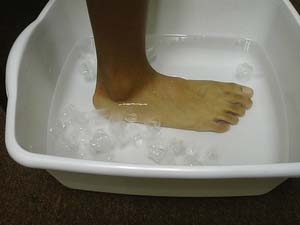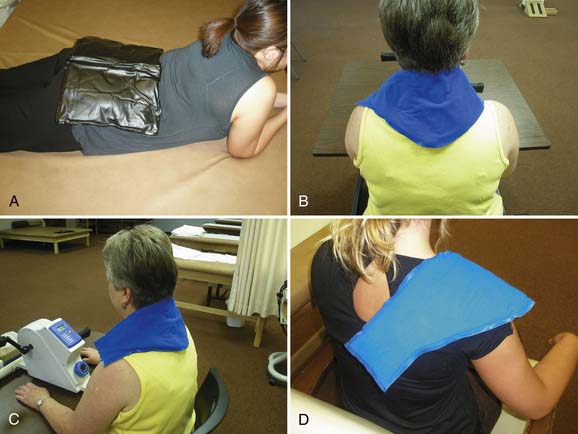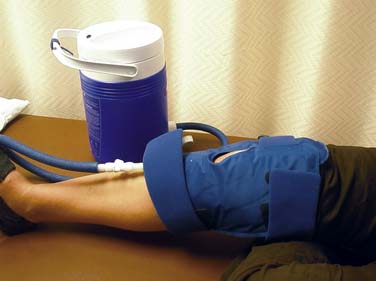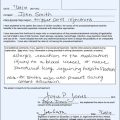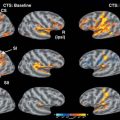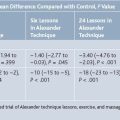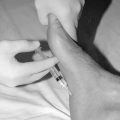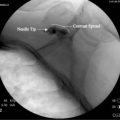45 Cold (Cryo) Therapy
Superficial physical agents such as cold, heat, light, friction, and pressure have been used in therapy for thousands of years. Cryotherapy, or the use of cold, is restricted to superficial agents that are inexpensive, easy to use and requires little time to prepare, usually simple, but effective. Ice and cold water are the usual agents, but vaporizing liquids, refrigerated units, and chemical packs may also be used. The application of ice to an injury, in the acute phase can substantially decrease the extent of the damage. Even though treatments are restricted to superficial application; cold therapy may produce longer-lasting physiologic changes than are possible from heat treatments of similar intensities.1
Biophysics
Chilling a limited portion of the body results in a number of local and distant physiologic changes. Although there is some controversy,2 most clinicians feel that there is an initial period of vasoconstriction due to the local reflexes and increased sympathetic constrictor tone.3,4 Vasoconstriction is thought to continue until subcutaneous temperatures fall to about 15° C/59° F. Below 15° C/59° F, vessels dilate, probably as a result of contractile mechanism paralysis or blockage of constrictor signals. An oscillating “hunting” pattern of constriction and reactive hyperemia may occur, at least in the digits, as was described by Lewis.2,3 At 0° C/32° F, skin blood flow may be greater than normal.
If the cooling agent is ice, skin temperature will initially decrease rapidly and then will more slowly approach as equilibrium temperature of about 12 to 13° C/54 to 55° F in 10 minutes. Subcutaneous temperatures decline more smoothly and in 10 minutes will fall to 3 to 5° C/37 to 41° F. Deep muscle temperatures decrease the least, and in 10 minutes may lessen by a degree or less.5 Chilling for longer periods result in more pronounced effects and intramuscular forearm temperature decreases of 6 to 16° C/43 to 61° F are reported following periods of 20 minutes to about 3 hours of vigorous cooling.6,7,7a Vasoconstriction reduces blood flow and the return of cooled tissue to normal temperatures is slower than in heated and hyperemic tissue.
The amount of energy that tissue will gain or lose during treatment depends on the nature of the tissue itself, the treatment modality involved, and the duration of exposure. In addition, the body places physiologic limits on the amount of cold it will tolerate. For example, exposure of skin to temperatures below 13° C/55° F are uncomfortable, and if the body is cooled below 28° C/82.4° F, death may occur.3
Effects of Cold Therapy
Pain Relief
The reason behind the application of ice resulting in pain relief is not clear. There are many theories and it is possible that a number of proposed mechanisms in combination can cause pain relief.7b,7c Some of the possible mechanisms include the following:
Reduction of Muscle Spasm
Muscle spasm is often a response to pain. The muscles surrounding an injury contract to protect the underlying tissue (muscle guarding) and prevent further damage.7e,7f,7g Ice, being useful for pain relief, is therefore advantageous in reducing muscle spasm. In addition, muscle overuse or imbalances can be improved through the use of cold therapy. This mechanism is not fully understood, but is believed to be due to ice slowing conduction velocity of sensory and motor nerves, as well as the activity of muscle spindle cells (responsible for muscle tone), resulting in a decrease in motor activity.
Slowing of the Metabolic Rate
By reducing the metabolic rate, ice reduces the oxygen requirements of the cells. Thus, when blood flow has been limited by vasoconstriction, the risk of cell death due to oxygen demands (secondary cell necrosis) will be lessened.
Research Studies
Taber,8 and others have evaluated local vascular response during cryotherapy. Their study was performed to determine whether application of a cold pack reduced blood volume in a nontraumatized ankle. Changes in local blood volume at the ankle were measured over a 20-minute period for the following three conditions: rest, room-temperature gel pack application, and cold gel pack application. A significant reduction in local blood volume was found for the cold gel pack condition in comparison with the resting condition. Maximum decrease in blood volume occurred at 13.5 minutes after cold gel pack application. Reactive vasodilation was not observed. The results lend support to the clinical use of a cold gel pack when a reduction in local circulation is desired, such as in the management of acute-phase soft tissue trauma.8
Belitsky,9 and others compared the ability of wet ice (WI), dry ice (DI), and cryogen packs (CGPs) to reduce and maintain the reduction of skin temperature directly under the cooling agent and to determine whether the cooling effect on skin extended beyond the surface area in contact with the cooling agent. Each of the three cold modalities was applied randomly to the skin overlying the right triceps surae muscle. The only significant differences in cooling were between WI and DI and between WI and CGP. Fifteen minutes after removal of the cold modalities, no significant differences were found in mean skin temperature between WI, DI, and CGP. No cooling was demonstrated 1 cm proximal or distal to any of the cooling agents after 15 minutes of cold application.
Akgun and colleagues10 concluded that with increased cold gel pack application time, the duration of cooling effect increased while the deep tissue temperature decreased. The length of application time and the duration of cooling effect were not linearly related. This ratio decreased progressively after 20 minutes.
The ice pack and mixture of water and alcohol were found to be significantly more efficient in reducing skin surface temperature than the gel pack and frozen peas.11 Cold whirlpool was found to be superior to crushed-ice packs in maintaining prolonged significant temperature reduction after treatment.12 Wetted ice was found to be superior to cubed or crushed ice at reducing surface temperatures, whereas both cubed ice and wetted ice were superior to crushed ice at reducing intramuscular temperatures.13 Application of an ice pack containing at least 0.6 kg of ice leads to a greater magnitude of cooling compared with application of a 0.3 kg ice pack, regardless of the size of the contact area.14
How to Apply Cold Therapy
Ice Baths
An ice bath can easily be made by half-filling a large container/tub with cold water and ice. The size of the container and depth of the water required depends on the body part to be treated. This is the best method of cooling awkward, bony areas, such as the foot, ankle, hand, and elbow. Immediately following injury, submerging the injured body part may not be as beneficial as using a cold pack and compression wrap because there is no compression (RICE principle—rest, ice, compression, and elevation). Wrapping the ankle prior to submersion will also prevent maximal cooling by insulating the body part (see Fig. 45-1).
Ice Massage
Ice massage is another cold (cryo) therapy technique. Place clean tap water into a foam cup, or specially designed cup and place in your freezer until it is completely frozen. Peel back a small amount of the top of the cup and massage this onto the area of pain using constant circular motion. Do not hold the ice in one area for more than 3 minutes because this may cause frostbite. Ice massage therapy can be repeated two to three times a day (see Fig. 45-2).
Gel Packs
These commercially available packs contain a gelatinous substance, which is kept frozen in a freezer until required. Better examples contain some form of anti-freeze which prevents the gel from freezing into a rigid position, allowing the pack to be molded to the shape of the body part. These are good for use in a clinic setting because they are reuseable and not as messy as ice packs. However, when taken out of the freezer, they immediately begin to thaw and so are not suitable for use on the field of play. They must also be applied to the skin through a towel or cloth to prevent frostbite (see Fig. 45-3).
Cryocuff
The Cryocuff is a machine that consists of a gallon tank of ice water and a nylon sleeve, into which you place the injured part. The ice water flows through the cuff to cool the body part. The tank must be raised to allow more water to flow into the cuff and increase the pressure. In this way, compression is also applied to the injury. To cool the water sitting in the cuff, the tank is lowered to allow it to flow back into the tank where it mixes again with the ice water. The tank can then be raised again to fill the cuff. The Cryocuff allows a good degree of cooling and compression, is relatively portable, and is reuseable. Different shapes and sizes of cuff can be used to allow for all body parts (see Fig. 45-4).
Conclusion
Cryotherapy decreases the amount of bleeding by vasoconstriction into the injury site, thereby reducing swelling, pain, and the risk of cell death. Cryotherapy also reduces the rate of metabolic activity, lessens muscle tone, and inhibits spasticity and clonus.7,15,16 This form of treatment has also been shown to increase gastrointestinal motility,17 slow nerve conduction, and produce analgesia. Any type of cold application should be stopped when the skin feels numb.
1. Basford J.R. Physical agents and biofeedback. In: DeLisa J.A., Currie D.M., Gans B.M., et al, editors. Rehabilitation Medicine: Principles and Practice. Philadelphia: JB Lippincott; 1988:257-271.
2. Knight K.I. Circulatory effects of therapeutic cold applications. In: Cryotherapy: Theory, Technique and Physiology. Chattanooga, Tenn: Chattanooga Corp; 1985:83-100.
3. Franchimont P., Juchmes I., Lecomite J. Hydrotherapy—Mechanism and Indications. Pharmacol Ther. 1983;20:79-93.
4. Guyton A.C. Muscle blood flow during exercise: Cerebral, splanchnic, and skin blood flows. In: Guyton A.C., editor. Textbook of Medical Physiology. Philadelphia: WB Saunders; 1986:336-346.
5. Lehmann J.F., deLateur B.J. Diathermy and superficial heat and cold therapy. In: Kottke F.J., Stillwell G.K., Lehmann J.F., editors. Krusen’s Handbook of Physical Medicine and Rehabilitation. Philadelphia: WB Saunders; 1982:275-350.
6. Alcorn R., Bowser B., Henley E.J., Holloway V. Fluidotherapy and exercise in the management of sickle cell anemia. A clinical report. Phys Ther. 1984;64:1520-1522.
7. Hartviksen K. Ice therapy in spasticity. Acta Neurol Scand. 1962;38:79-84.
7a. Brown W.C., Hahn D.B. Frostbite of the feet after cryotherapy: A report of two cases. J Foot Ankle Surg. 2009;48(5):557-580.
7b. Ebersold M.J., Laws E.R., Stonnington H.H., Stillwell G.K. Transcutaneous electrical stimulation for treatment of chronic pain: A preliminary report. Surg Neurol. 1975;4:96-99.
7c. Greenstein G. Therapeutic efficacy of cold therapy after intraoral surgical procedures: A literature review. J Periodontal. 2007;78(5):790-800.
7d. Abramson D.I., Chu L.S., Tuck S.Jr., et al. Effect of tissue temperatures and blood flow on motor nerve conduction velocity. JAMA. 1966;198:1082-1088.
7e. Harris E.D.Jr., McCroskery P.A. The influence of temperature and fibril stability on degradation of cartilage collagen by rheumatoid synovial collagenase. N Engl J Med. 1974;290:1-6.
7f. Wright V., Johns R.J. Quantitative and qualitative analysis of joint stiffness in normal subjects and in patients with connective tissue diseases. Ann Rheum Dis. 1961;20:36-46.
7g. Lehmann J.F., Masock A.J., Warren C.G., Koblanski J.N. Effect of therapeutic treatments on tendon extensibility. Arch Phys Med Rehabil. 1970;51:481-487.
8. Taber C., Contryman K., Fahrenbruch J., et al. Measurement of reactive vasodilation during cold gel pack application to nontraumatized ankles. Phys Ther. 1992;72:294-299.
9. Belitsky R.B., Odam S.J., Hubley-Kozey C. Evaluation of the effectiveness of wet ice, dry ice, and cryogen packs in reducing skin temperature. Phys Ther. 1987;67(7):1080-1084.
10. Akgun K., Korpinar M.A., Kalkan M.T., et al. Temperature changes in superficial and deep tissue layers with respect to time of cold gel pack application in dogs. Yonsei Med J. 2004;45(4):711-718.
11. Kanlayanaphotporn R., Janwantanakul P. Comparison of skin surface temperature during the application of various cryotherapy modalities. Arch Phys Med Rehabil. 2005;86(7):1411-1415.
12. Myer J.W., Measom G., Fellingham G.W., et al. Temperature changes in the human leg during and after two methods of cryotherapy. J Athl Train. 1998;33(1):25-29.
13. Dykstra J.H., Hill H.M., Miller M.G., et al. Comparisons of cubed ice, crushed ice, and wetted ice on intramuscular and surface temperature changes. J Athl Train. 2009;44(2):136-141.
14. Janwantanakul P. The effect of quantity of ice and size of contact area on ice pack/skin interface temperature. Physiotherapy. 2009;95(2):120-125.
15. Knutsson E., Mattson E. Effects of local cooling on monosynaptic reflexes in man. Scand J Rehabil Med. 1969;1:126-132.
16. Miglietta O. Action of cold on spasticity. Am J Phys Med. 1973;52:198-205.
17. Bisgard J.D., Nye D. The influence of hot and cold application upon gastric and intestinal motor activity. Surg Gynecol Obstet. 1940;71:172-180.

